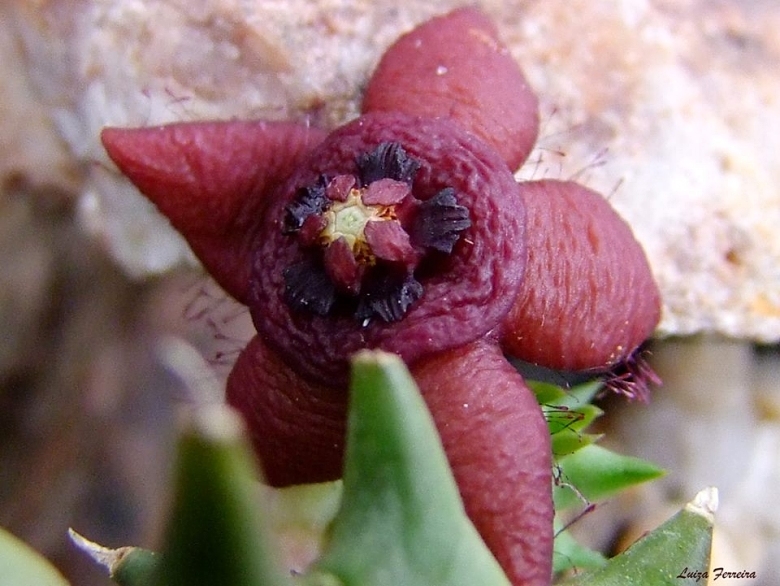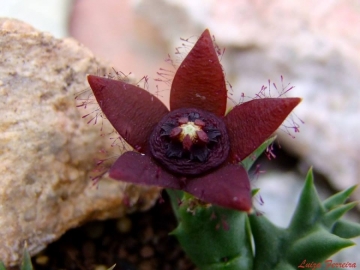
Orbea semota subs. orientalis Photo by: Luiza Ferreira
Origin and Habitat: Kenya and Tanzania (Kilimanjaro Province).
Type Locality: Taita distr., near Bura, 1200 metres above sea level.
Synonyms:
See all synonyms of Orbea semota
back
Accepted name in llifle Database:Orbea semota subs. orientalis BruynsSyst. Bot. Monogr. 63: 136 (2002)Synonymy: 2
Accepted name in llifle Database:Orbea semota (N.E.Br.) L.C.LeachKirkia 10(1): 290 1975Synonymy: 6
back
Description: Orbea semotaSN|30311]]SN|30311]] subsp. orientalis is a distinct pant distinguished from the type by it smaller solid brown flowers and slightly less boldly toothed stems.
In subsp. semota the corolla is at least 3.5 cm in diameter, whereas in subsp. orientalis it is at most 2.5 cm in diameter. The corolla lobes are only 7-8 mm long (at least 12 mm in subsp. semota), and the annulus is at most 8 mm in diameter. The gynostegium is slightly smaller, too, but is not quite in proportion to the size of the corolla. The pollinia of the subspecies are also considerably smaller.
Chromosome number: 2n = 22.
Notes: The flowers of Orbea semotaSN|19768]]SN|30311]] ssp. orientalis have a pungent foetid smell of of poop. The scent profiles are species-specific and independent of generic affiliation. The scent of Orbea semotaSN|30311]]SN|30311]], for example, is quite different from the scent of Orbea variegataSN|30311]]SN|19768]]. O. semota was especially characterized by high amounts of p-cresol and butanoic acid, whereas these compounds were either not found or found in very small amounts in O. variegata. In contrast, the most abundant compound of O. variegata was dimethyl trisulphide, which was not present at all in O. semota.
Bibliography: Major references and further lectures
1) John Hunter Thomas “Systematic Botany Monographs” American Society of Plant Taxonomists, 2002
2) Andreas Jürgens, Stefan Dötterl and Ulrich Meve “The chemical nature of fetid floral odours in stapeliads (Apocynaceae-Asclepiadoideae-Ceropegieae)” Article first published online: 4 AUG 2006 New Phytologist Volume 172, Issue 3, pages 452–468, November 2006
3) Mauro Grabiele, Ana I. Honfi & Julio R. Daviña “IAPT/IOPB chromosome data 10” Marhold (ed.) TAXON 59 (6): 1934–1938 December 2010.
 Orbea semota subs. orientalis Photo by: Luiza Ferreira
Orbea semota subs. orientalis Photo by: Luiza FerreiraSend a photo of this plant.The gallery now contains thousands of pictures, however it is possible to do even more. We are, of course, seeking photos of species not yet shown in the gallery but not only that, we are also looking for better pictures than those already present.
Read More... Cultivation and Propagation: Orbea semotaSN|30311]]SN|30311]] subs. orientalis is an easy blooming plant when mature that require moderately watering through the growing season but enjoy plenty of water and some fertiliser in hot weather, this helps them to flower freely. Water more sparingly in winter according to temperatures. But, as with most asclepiads, it is unwise to leave them wet in cold weather. Winter care presents no problems at 5°C with plenty of light. Since roots are quite shallow, use a cactus mix or add extra perlite or pumice to regular soil potting soil. A gritty, very free-draining compost is suitable, and clay pots help the plants to dry out between watering.
Sun Exposure: Partial sun or light shade
Pest and diseases: Stapelia species vary in their susceptibility to rotting, but are generally fairly easy to grow, especially if kept pest-free. They are very susceptible to stem and root mealy bugs, and damage from these may well initiate fungal attack. If you do have problems with a stem or with basal rotting, you can reliably isolate the healthy parts, dry them off, and re-root them in moist compost.
Cultural Practices: Re-pot every 2 years
Propagation: Easiest with stem cuttings. Allow cuttings to dry a day before planting. Stems must be laid (Not buried) on gritty compost and will then root from the underside of the stems. It can also be increased from seeds sowing in spring in moist, sandy peat moss.
Potting medium: Since roots are quite shallow, use a cactus mix or add extra perlite or pumice to regular soil potting soil. A gritty, very free-draining compost is suitable, and clay pots help the plants to dry out between watering.











